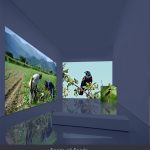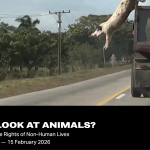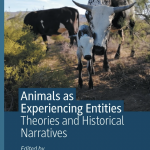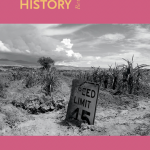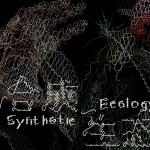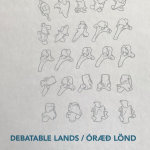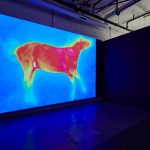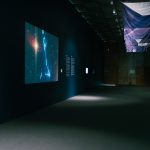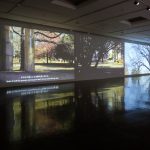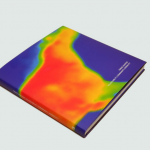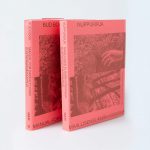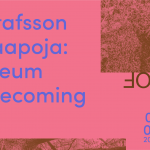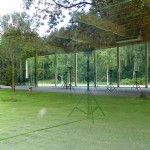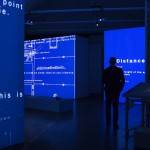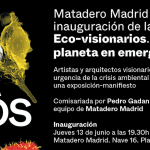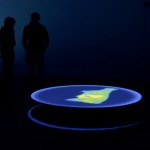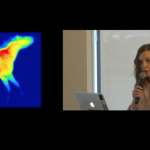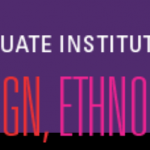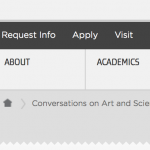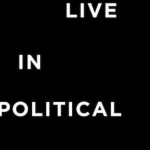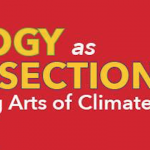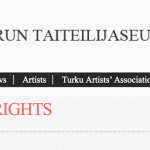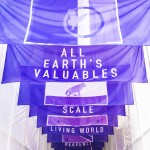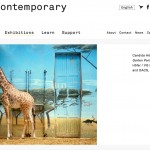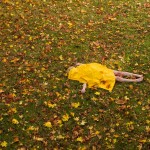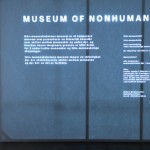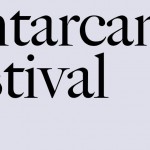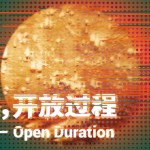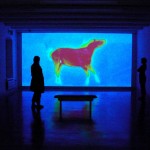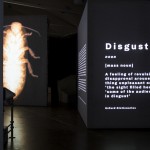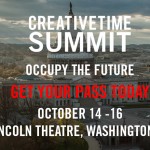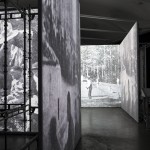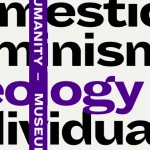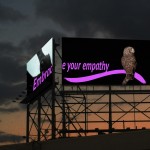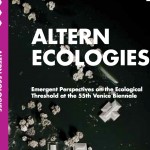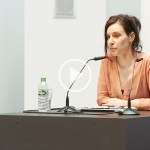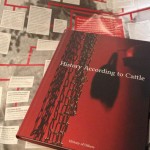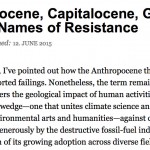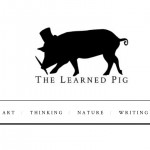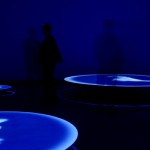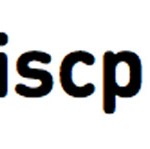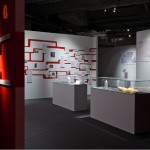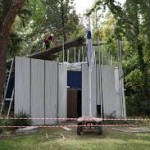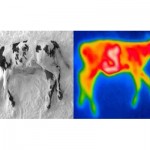In: Bud Book – Manual for Earthly Living (Ed. Gustafsson&Haapoja, Garret / HAM 2020)
Instead of a climate crisis, it would more accurate to talk about a crisis of humanity. The image that has emerged in public discussions over the last decade, of the human being who destroys, corrupts and kills, is fundamentally different from the image of the human being of the ages of enlightenment and progress, as a figure who develops the world and makes it a better place. Every day, we read about how this ‘human being’ is irrevocably changing the world with their actions and, at the same time, destroying the basic requirements for life as we know it.
The concept of the Anthropocene, which came out of discussions within geology, is an attempt to give a name to this state of affairs. According to the basic thesis put forward by the researchers Paul Crutzen and Eugene Stoermer in 2000, the impact of human beings on the world is so profound that it is possible to separate off the age of ‘mankind’ (Crutzen and Stoermer’s term) into its own geological era.1 Crutzen and Stoermer write how the impact of humankind extends everywhere in the world, even to the moon, and how humankind is spreading environmentally toxic substances and has exhausted fossil-fuel reserves that accumulated over millions of years. This humankind has transformed the globe so fundamentally that its impact can be seen from space and can be identified in the strata of the Earth’s crust. Crutzen and Stoermer propose as a starting point for the Anthropocene era the latter part of the 18th century and the start of industrialization. Subsequently, The Anthropocene Working Group set up under the International Commission on Stratigraphy decided to propose that the start of the epoch be set at the mid-20th century, when the effects of industrialization began to be visible globally.2 One suggested marker is the first nuclear bomb tests and the fallout they produced, which due to its long half-life will still be detectable in geological strata tens of thousands of years from now.
The concept of the Anthropocene views human beings as subjectless agents, like a force of nature, its actions being directed not so much by political struggle as by an ungoverned, species-specific hive intelligence guided by a short-term pursuit of interests. This, on the one hand, exalts humankind to being an agent that possesses planetary powers, and, on the other hand, portrays humanity as a mass resembling a herd of lemmings that is in danger of being destroyed, the victim of its own mindlessness. This politically neutral image of humanity (or “mankind”) as the cause of the climate crisis recurs frequently in the rhetoric of environmental activism and politics that governs the mainstream, and which locates the problem in that same human’s relationship with nature or its habits of consumption. This generalizing language, however, conceals the power structures that underlie both the concept of humanity and the climate crisis.
The researchers Heather Davis and Zoe Todd point out that the Anthropocene is not some sudden geological event, but a manifestation of hundreds of years of colonialist violence done to people and nature. According to Davis and Todd, the universalism of the Anthropocene discourse tells us that science discussions are inherently a part of the colonialist tradition, which hides both that violence and non-Western perspectives.3 The art historian T. J. Demos in turn, argues that the Anthropocene discourse acts as a universalizing mechanism that makes it possible to conceal the actors behind climate change and to shift responsibility from them onto the shoulders of the whole of humankind.4 According to Davis and Todd, colonialism is always already about terraforming and pushing aside existing ecosystems, the effects of which extend from the Earth’s crust to human and animal communities, and the atmosphere. The industrialism and petrocapitalism proposed as landmarks for the Anthropocene have thus arisen on the foundation created by the Transatlantic slave trade and the genocide of Indigenous peoples.5
In her research on the intertwined histories of the Anthropocene, geology and racism, Kathryn Yusoff writes about how the categories human/inhuman or living/non-living produced by colonialism have constituted major ways of setting up hierarchies, both between human beings and in humanity’s relationship with nature. The inhumanness projected onto the enslaved African peoples was linked with geological extractivism, in which the inhuman (earth and minerals, enslaved humans, nonhuman animals) was there to be freely exploited by white Europeans. According to Yusoff, geology – both as a science discipline and as a practice – is historically a power relation that has produced, and still produces, racial categories.6 For Davis and Todd, the purportedly neutral geological markers constituted in Anthropocene narratives – coal, plastic, plutonium, uranium or cement – are in fact wounds left in the earth by political actions. They contend that dating the start of the Anthropocene to the conquest of the American continents, instead of the mid-20th century as proposed by The Anthropocene Working Group, would take this cumulative history into account. This would also create room for taking the Indigenous peoples’ viewpoint into consideration as part of the discussion of the environment crisis. Davis and Todd support Simon Lewis and Mark Maslin’s proposal to put the start of the Anthropocene at 1610, when the atmospheric carbon-dioxide level fell so significantly that it can be pinpointed using geological methods. This event dubbed the “Orbis Spike” was caused by the mass killing of the Indigenous peoples of the Americas, resulting in a regrowth of forests on the abandoned farmlands, which then began to act as carbon sinks.7 The first measureable, anthropogenic disruption of nature with a global impact was thus a direct consequence of a genocide that took the lives of 50 million people.
Theorists from different disciplines have put forward countless alternatives to the idea of the Anthropocene. For example, Donna Haraway writes about how the concept of the Anthropocene conceals the practices behind mass extinctions, which view land, people and other species solely as a resource for production. In place of the Anthropocene, Haraway proposes the concepts of the Capitalocene or the Plantationocene, which better express the phenomenon’s cultural underpinnings.8 Nicholas Mirzoeff, in turn, proposes the term White Supremacy Scene, referring like Yusoff to the intertwined histories of the science of geology and racism.9
What these critiques of the Anthropocene have in common is a demand that we keep in view the political structures underlying the environmental crisis. The build-up of carbon dioxide in the atmosphere is not a passive, subjectless event, but has locatable causes and culprits. The agent of climate change is not the climate, but real human individuals, who run corporations, states and governments, declare wars, and develop moral theories. Climate change is thus not so much a matter of an inflamed relationship with nature, as of capitalism and imperialism, and of the understanding of the world, values, development or the good life that is their cultural foundation. This being the case, the environmental crisis cannot be solved without taking global social justice into account.
Thus, the ‘human being’ of the Anthropocene refers not so much to the human species as to a specific definition of the human being and to the group of human beings that benefit from it. Instead of blaming the politically neutral, universal ‘human being’, we should ask: Who exactly is this human being who is responsible for planetary destruction?
The image of humanity of enlightenment thinking, with its belief in progress, has been challenged by numerous philosophical movements, which can be bundled together under the title posthumanism. What these movements have in common is the idea of the human being as a social and historical construct, as opposed to the essentialist concept of humanity of the tradition of humanism. The literary scholars Karoliina Lummaa and Lea Rojola write about how the privileged image of human beings as the crown of creation was shaken in the 1960s by structuralist and post-structuralist thinking, in which the human being was seen, not as a clear-cut figure, but as a product of language and culture.10 If the concept of the human was socially constructed, it was also possible to dismantle and rebuild it.
Calling into question the difference between human and animal has been seen as a key to that job of dismantlement. In the tradition of humanism the specificity of the human being has generally been justified by saying that the human being is essentially different from other animals. But because the human being is, in fact, also an animal, the identity of humanity understood thus also relies on our rejecting our own animality. At the same time, the animal becomes humanity’s rejected other, that represents everything that is undesirable in humanity. The concept of the animal thus also produces a moral category, in which violence towards these “lower creatures” becomes acceptable. We explore this distinction and its violent consequences in the Museum of Nonhumanity project (Gustafsson&Haapoja 2016-).11 A crucial part of this distinction is that it does not follow species boundaries. Since, in the tradition of the enlightenment, the norm for the human being is the white, heterosexual, European man, everyone who diverges from that norm is in danger of being treated as being less human. Racism, sexism, homophobia and transphobia are case examples of animalization. Social and moral othering almost always relies specifically on animalization, on seeing others as less human, and hence as less protected by the safety nets associated with humanity.
The philosopher Syl Ko argues that the mechanism of the animalization that is a characteristic of the modern world should, nevertheless, also be understood in the light of the paradigm of racism instigated by colonialism.12 According to Ko, the idea of hierarchies of humanity, which emerged during the conquest of the Americas and the Transatlantic slave trade, in other words, of people who are intermediate forms between human and animal, also substantially changed the way that the distinction between human and animal was conceptualized. The idea of the sub-human that arose along with the concept of race appeared alongside the animal of a different species as a counterpart to the normative human being. In the paradigm of racism the basis for the animalization of racialized human groups was their supposed closeness to animals on the spectrum of humanity. Correspondingly the violence visited upon animals is intertwined with the racist imaginary.
All the various tendencies in posthumanism seek to dismantle these violent pairings of opposites. Lummaa and Rojola stipulate as a key starting point for posthumanist thinking the idea of the human being who is not defined in an oppositional relationship with the non-human.13 In the light of Syl Ko’s thinking, it has to be pointed out that this also means a dismantling of the hierarchies in-built into the paradigm of racism and into the Western notion of ‘humanity’. Ko nevertheless points out that the work of dismantling the western conception of the human has actually been going on for much longer in non-Western traditions of thought.14 For example, in the thinking produced by the African diaspora and in postcolonial thinking, the Europe-centred model of humanity linked to white supremacy has long been critiqued. These traditions approach the humanity of the enlightenment from the outside, asking: What did the enlightenment ideals of progress or rationality look and feel like to those who were the object of the actions that they were used to justify. The philosopher Zakiyyah Iman Jackson asks whether we should in fact think of the superseding of “the human” proposed by posthumanism as coming after it geographically rather than temporally: since thinking that is not tied to western humanism, and which is critical of it, has existed the whole time.15
What these tendencies in thought have in common is a critique of the hierarchical conception of human beings based on binary opposites. Understanding the human as a unique being that has been raised to special moral status serves as a justification for using everything that is considered of lower status as a resource. The roots of the current global market economy lie in the multi-century enslavement of large sections of the African population, which in cotton production and as a workforce also made possible the industrialization of Europe. Capitalism needs animalized people and other creatures that production can exploit: surplus is always literally extracted from someone’s body. Dismantling the concept of the human being thus inevitably also requires a dismantling of the logic of capitalism, and vice versa.
Instead of being ‘a consequence of human actions’ the climate crisis is a result of a conception of the human that has for centuries justified the exploitation of others for the benefit of the few. Those others are both oppressed peoples and human groups as much as they are nature and all the other species that are reduced to being an economic resource. The power relations underlying the climate crisis follow these demarcation lines: rich, white, western countries maintain control of most of the world’s wealth, at the same time as they are responsible for most of the climate emissions. Correspondingly the first to suffer from the climate crisis are specifically those off whose backs the rich have become rich: the global South, women, the poor, and racialized people, and, of course, also animals and natural areas that disappear to make way for industrial “development”. Changing the conception of the human is thus not theoretical, but an acute political issue. Beneath concrete political climate actions lies this other, equally fundamental question.
How to become human?
The art of becoming otherwise
What then can art contribute to this process? Can art that is intertwined with the individuality and the logic of goods production preached by capitalism challenge the prevailing ways of thinking? The political theorist Chantal Mouffe writes about how the possibility of art acting as a political counterforce has become increasingly difficult in a post-Fordist society, where the creative economy employs means that traditionally belonged to art. Seen from this viewpoint, a radical resistance could only exist outside of institutions. But, for Mouffe, it is specifically because culture is so intrinsic a part of capitalism that it is possible for it to disrupt the hegemony’s symbolic order and to produce new subjectivities.16
Mouffe sees the political arena as in its starting points an agonistic place: in politics different ways of organizing the world, ways that cannot be brought neatly to a compromise, compete. One prevalent order always excludes others. Because the prevailing order is not based on any law of nature, it can always be challenged. For Mouffe, places of political struggle are not limited to the traditional political arenas, but include all discursive spaces where a shared reality is produced and maintained. For that reason art can also participate in counter-hegemonic struggle from inside institutions, changing them and reconstructing them. In the neoliberal capitalism that governs the world today that challenge means an anti-capitalist resistance, and disrupting and exposing the mechanisms of capitalism. But the politics of representations alone is not enough: we also need traditional political action and organization.17
The philosopher Jacques Ranciére understands the relationship between art and politics as being even more active. According to Ranciére, the way we make sense of the world always occurs in accordance with covert principles of social organization. Ranciére talks about “the distribution of the sensible”, the way sensory reality is “shared” as understandable categories and forms that also determine what kinds of roles there can be in the community. The unspoken rules and unseen coordinates constitute a structure through which certain things emerge in the cultural consciousness and others remain in the background, certain voices can be discerned as speech and others as noise, or certain social roles are made possible for the few, while at the same time being produced as impossible for others. For Ranciére politics is not represented by traditional social institutions, which he calls “police”. The task of this police is to maintain the established way of distributing sensible reality and its categories and hierarchies, and also to oversee the permanence of normalized structures. Politics, in contrast, is any action that puts forward other ways of distributing reality. In other words, politics is not so much a matter of managing political institutions, laws and the community, as of marginalized and silenced voices being heard, i.e. challenging the order upheld by that police function. This challenging also makes visible the way that the existing order is not ‘natural’; human society can be organized in any way at all, and what appears natural is just an ossified practice. For Ranciére the tight-knit relationship between art and politics is linked to their connection with form: if the political is understood as re-distribution of the sensible, then politics is also aesthetic in nature. The bringing up of new forms that occurs in art is also a bringing up of new ways of speaking, the possibility of new social choreographies or different power structures. For Ranciére the political is, in this sense, always already aesthetic, and the aesthetic always already a part of the political process.18
Both Mouffe and Ranciére approach art’s political potential via the aesthetic tradition. Starting as far back as Plato, art has been understood in relation to form: in Ranciére’s words it is “doing and making”.19 Art conceived thus is the production of (visual, aural, choreographic or conceptual) forms, and critical art a destabilizing of the prevailing symbolic order through the production of new kinds of forms. Seen from these starting points artistic doing and making do not essentially diverge from other doings and makings. In the field of political art it is, in fact, typical to see art through a kind of optics of alienation: the artist captive in capitalism is just another underpaid worker, whose rights should be restored, and an artwork is a product stuck in the cycle of commodity fetishism and has to be rescued from the logic of the market.
The tradition of aesthetics, however, overlooks something essential about the practice of art: art is not just doing and making, but is also being. Artistic being is a crucial part of making art: it precedes doing and making and is a precondition for them. Making art requires being emotionally and mentally open to the world; you have to be present, to let the things of the world touch, disturb, and amaze you. In this sense art is less reminiscent of production and more of a relationship. In an artistic relationship with the world there is an intimacy that is not fundamentally different from the intimacy of interpersonal relationships. In this kind of intimacy the other’s features become hard to make out: the other no longer appears as an image, as something easily compartmentalized, but as multi-dimensional and indefinable. Intimacy makes it possible to become otherwise, and also to let the other become otherwise. Whereas in an interpersonal relationship the presence and attention of the other creates a security within which vulnerability is possible, in artistic being it is the work (both working on artworks and the artworks themselves) that produces a shelter under which it is possible to be vulnerable and to let the world touch you. Thought of in this way, artistic being is dialogical in nature: it is thinking together with yourself, which is also thinking together with the world.
While artists are dedicated to nurturing and developing this way of being, we can easily assume that it is there as a potential in all human beings. Ranciére writes that the quintessential equality of all human beings as thinking creatures who experience the world is art’s liberating message. An artist is not content with simply possessing skills, but wants their work to be a means of expression, and to impart to others what they experience, and to be understood. A society of the emancipated would, in Ranciére’s words, be a society of artists.20
If, however, instead of doing and making, art is thought of as a way of being, both Ranciére’s example and Joseph Beuys’s famous phrase “every man is an artist”21 appear in a different light. The artistic potential contained in every human being lies not so much in their ability to be a participant in the production of social or aesthetic forms, but in their ability to create an intimate, non-predetermined and vulnerable relationship with the world; a relationship that makes it possible to be differently and to see the world differently. When the practice of art is thought of, not as doing and making, but as being, it is possible also to see the relationship between art and politics in a different way. Perhaps, rather than concentrating on the police function of art, i.e. on defining good and bad art or on organizing funding for art, we should strive towards a world in which as many people as possible are able to practice artistic being. Since, is there anything more radical in a world governed by capitalism than open, vulnerable, non-productive being?
In the state of becoming human
The people interviewed for Becoming do politics in Ranciére’s and Mouffe’s sense. In their various practices they bring up ways of being human that are overshadowed by the prevailing image of humanity, and at the same time they re-write the relationship with the non-human. The work and the thinking of these people open up a space in which it becomes possible to think of a different world: a world after capitalism, a world after sexism and racism, a world after animalization. They represent sections of the population left in the shadows by the western canon: specifically those who are generating constructive alternatives to the violent ideology of othering that underpins climate change. The future is of necessity not just feminist, but also non-binary, non-speciesist and non-hierarchical, because it is specifically patriarchy, speciesism, binary logic and hierarchical thinking that are behind the environment crisis.
The future and the coming of another kind of human being are essentially linked with not-knowing: nobody can know for sure in what way differentness can be reached, or what it is like there. Becoming otherwise means reaching towards something whose existence you cannot yet even detect. That is why it is also a state of being that requires an openness and quiescence, as in artistic being, to experiencing different ways of being in the world. That is why Becoming does not present a utopia of what the future world will be like. It does not open up in a linear narrative that could be taken under control: the work’s spatial scale and duration make this impossible. Instead, it presents itself as a place for thinking together, where encounters occur between people, between people and the landscape, and between people and their own thoughts. In this place the viewer, together with the interviewees, can feel their way towards possible futures and other ways of being human.
First published in: Gustafsson&Haapoja (Ed.): Bud Book – Manual for Earthly Living (Garret / HAM 2020)
References
Birrell, Ross, 2008. Jacques Rancière and The (Re)Distribution of the Sensible: Five Lessons in Artistic Research. Art &Research; Volume 2. No. 1.
Crutzen, Paul J. and Stoermer, Eugene F. 2000. The “Anthropocene”. Global Change Newsletter; no 41, p 17-18.
Davis, Heather and Todd, Zoe, 2017. On the Importance of a Date, or Decolonizing the Anthropocene. ACME An International Journal for Critical Geographies, 2017. pp. 761-780.
Demos, Tj, 2017. Against the Anthropocene – Visual Culture and the Environment Today. Berlin: Sternberg Press.
Gustafsson&Haapoja: Museum of Nonhumanity. http://museumofnonhumanity.org (1.1.2020)
Grosfoguel, Ramón, 2013. The Structure of Knowledge in Westernized Universities
Epistemic Racism / Sexism and the Four Genocides / Epistemicides of the Long 16th Century. Human Architecture: Journal of the Sociology of Self-Knowledge, XI, Issue 1, fall 2013, 73-90.
Haraway, Donna and Martha Kenney, 2015. Anthropocene, Capitalocene, Chthulhocene. In: Heather Davis and Etienne Turpin (eds.) Art in the Anthropocene: Encounters Among Aesthetics, Politics, Environments and Epistemologies. London: Open Humanities Press, pp. 255-270.
Haraway, Donna, 2015. Anthropocene, Capitalocene, Plantationocene, Chthulucene: Making Kin.
Environmental Humanities, vol. 6, pp. 159-165 http://environmentalhumanities.org
Jackson,
Zakiyyah Iman, 2013. Animal: New Directions in the Theorization of
Race and Posthumanism. Feminist Studies
39,
No. 3, pp. 669-685.
Ko, Aph and Syl, 2017.
Aphro-Ism
– Essays on Pop Culture, Feminism, and Black Veganism from Two
Sisters New York: Lantern Books.
Lewis, Simon L. and Maslin,
Mark A., 2015. Defining
the Anthropocene.
Nature, 12 March 2015, Vol 519, pp. 171 – 180.
Lummaa,
Karoliina and Rojola, Lea, 2014. Johdanto:
Mitä posthumanismi on? In:
Posthumanismi. Turku: Eetos. pp. 13-32.
Ly, Panang, 2019. An Interview with Syl Ko – Activism in terms of an epistemological revolution. In Tierautonomie. February 2019. https://simorgh.de/about/an-interview-with-syl-ko/
Mirzoeff, Nicholas, 2016. It’s Not the Anthropocene, It’s the White Supremacy Scene, Or, The Geological Color Line. In: Richard Grusin (ed.), After Extinction. Minneapolis: University of Minnesota Press.
Mouffe, Chantal, 2013. Artistic Strategies in Politics and Political Strategies in Art. emisférica, Issue 1, Vol 10, Dissidence, 2013. https://hemisphericinstitute.org/en/emisferica-102/10-2-dossier/artistic-strategies-in-politics-and-political-strategies-in-art.html (28.12.2019)
Mouffe, Chantal, 2007. Artistic Activism and Agonistic Spaces. Art & Research, Vol 1. No 2. Summer 2007. http://www.artandresearch.org.uk/v1n2/mouffe.html (28.12.2019)
Rancière, Jacques, 2008. Aesthetic Separation, Aesthetic Community: Scenes from the Aesthetic Regime of Art. Art &Research Volume 2. No. 1.
Ranciére, Jacques, 2004. The Politics of Aesthetics. London: Bloomsbury.
Ranciére, Jacques, 1991. The Ignorant Schoolmaster: Five Lessons in Intellectual Emancipation. Stanford, Cal.: University of Stanford, 1991.
Subcommission on Quaternary Stratigraphy; Working Group on the “Anthropocene” – Results of Binding Vote by AWG (May 2019)
http://quaternary.stratigraphy.org/working-groups/anthropocene/ (1.1.2020)
Suoranta, Juha, 2011. Osattomien politiikka. 1/2011 niin&näin 145 – 147
Wright, Stephen, 2008. Behind Police Lines: Art Visible and Invisible. Art &Research Volume 2. No. 1 Summer 2008
Yusoff, Kathryn, 2018. A Billion Black Anthropocenes or None. Minneapolis: University of Minneapolis Press.
1Crutzen and Stoermer, 2000
2 Subcommission on Quaternary Stratigraphy; Working Group on the “Anthropocene”, 2019.
3 Davis and Todd, 2017.
4 Demos, 2017, p. 9.
5 Davis and Todd, 2017.
6 Yusoff, 2019, p. 6, p. 10.
7 Lewis and Maslin, 2015, Davis and Todd, 2017
8 Haraway, 2015.
9 Mirzoeff, 2016.
10Lummaa and Rojola, 2014.
12Ko, 2017.
13Lummaa and Rojola, 2014.
14Panang, 2019.
15Jackson, 2013.
16Mouffe, 2007.
17Mouffe, 2013.
18Ranciére, 2004, p. 7–14; Ranciére, 2008.
19Ranciére, 2004, p. 8
20Ranciére, 1991 p. 65 and Ross, 2008.
21Joseph Beuys’s phrase refers to the idea of social organisations as a kind of collective sculpture. See, e.g. https://www.tate.org.uk/art/art-terms/s/social-sculpture (22.1.2020)
